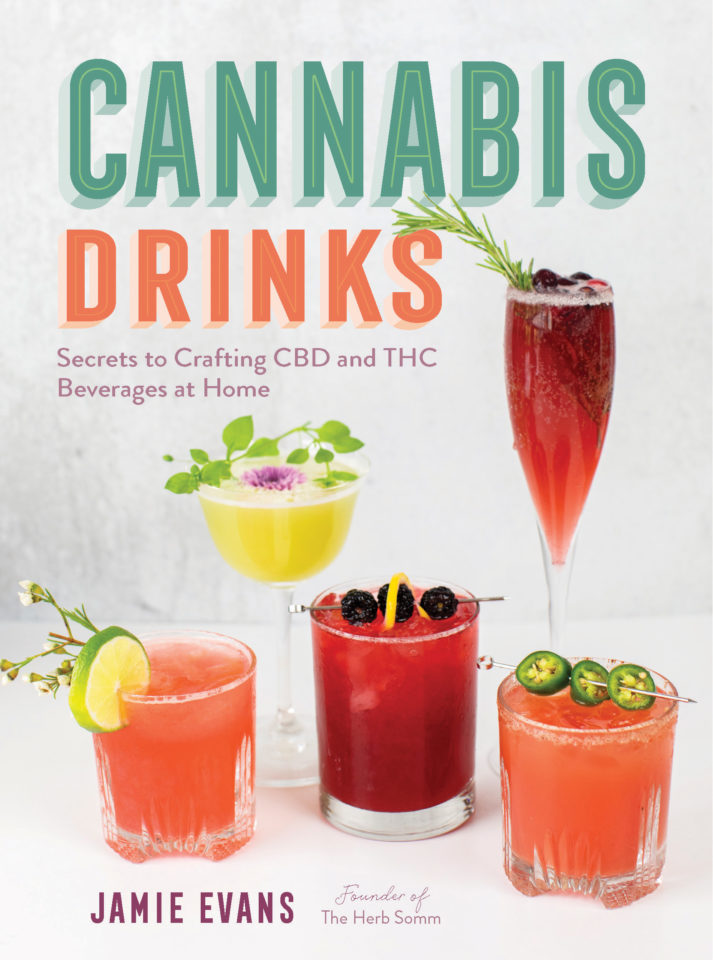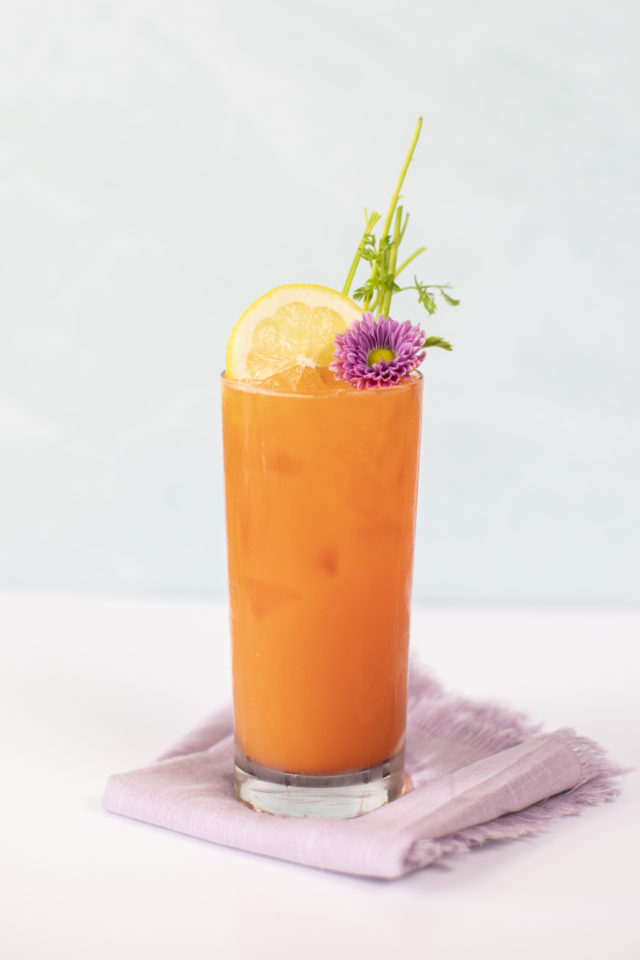In California, it’s called Cali sober, but all over the world people are switching from alcohol to cannabis-infused beverages, purposefully doing away with drunkenness, cognitive fumbling, and stumbling—and possibly that walk of shame the next morning—along with the hangovers. Harm reduction is the new buzzword for switching to weed, with people across the country choosing the plant over booze, stating it makes them better people, parents, and partners.
A Nose for Flavor
Wine specialist and sommelier turned cannabis beverage connoisseur, Jamie Evans, founded The Herb Somm in 2017. The blog and lifestyle brand hosts high-end, gourmet cannabis-infused dinners curated with wine and cannabis. Her first book, The Ultimate Guide to CBD: Explore the World of Cannabidiol, was released in 2020 and features recipes infused with CBD. Her second book, Cannabis Drinks: Secrets to Crafting CBD and THC Beverages at Home, was released in 2021.
“Cannabis drinks are a fantastic alternative to alcohol,” Evans said. “With the new low-dose options that are now available, these beverages can offer a similar experience to drinking one glass of wine or a beer, but without the hangover. Market trends are also showing that more consumers are seeking alternatives to alcoholic beverages for health reasons, which has been driving new curious consumers to the cannabis drinks category.”
In 2021, Evans launched Herbacée, a cannabis-infused beverage company, “celebrating flower and vine.” Evans said the iconic wine regions of France inspired Herbacée. The non-alcoholic cannabis beverage blends phytocannabinoids (cannabinoids derived from plants), terpenes (aromatic compounds which contribute to taste and smell), tannins (a bitter, astringent compound found in things like wine), and terroir (characteristic tastes imparted by the natural environment).
“In researching cannabis, I came across many similarities between the plant and wine, including farming practices and sensory evaluation techniques,” Evans said. “Mixology is defined as the skill of mixing cocktails and other drinks, but at its core, it’s the extensive study of the art and craft of combining flavors.”

Cannabis Cocktails
With her new drinks guide, Evans offers recipes, tips, and tricks in making cannabis-infused craft cocktails, smoothies, lattes, and spirit-free mixed drinks at home. Basic infusions include making age-old bitters, honey, sour mix, simple syrups, and alcohol-based tinctures. Using a technique she calls “infused mixology,” the book teaches the basic building blocks of crafting marijuana mocktails.
“One of the most important things to making a good cocktail is balance,” Evans said. “As with all drinks, we must evaluate whether the drink is too sweet or too sour? Is it complex or simple? What’s the texture like? How can you make this drink more intriguing and palatable? Once you can achieve balance, you’ve created a good cocktail. Also, remember that every ingredient that goes into the beverage is meant to enhance the complexity, structure, mouthfeel, and backbone.”

The Future is Fluid
Evans is excited for more people to try their hand at making cannabis cocktails.
“I am enthusiastic about the future of cannabis cuisine, cannabis restaurants, and cannabis-infused beverage bars,” she said. “In my opinion, making your own infusions, such as cannabis-infused simple syrup or cannabis-infused bitters, is the best method to use since it allows you to customize the infusion based on your personal preferences.”
Cannabis infusions will also combine into drinks seamlessly versus using a commercially-made oil tincture. Evans said the only downside with making your own infusions is calculating the dosage. With homemade creations, the milligram count will never be as precise as using a professionally-made product.
If you don’t have time to create your own infusions, Evans suggests adding an alcohol or oil tincture to infuse drinks.
“Dosing in this way is easy when using a measured tincture or water-soluble formulations that have already been tested with protocols,” she said. “CBD isolates using just one compound from the plant, cannabidiol, are another way to infuse a beverage. They are typically flavorless, odorless and are a fast and potent way to integrate CBD into your regime.”
Evans noted consumers can also utilize beverages already infused with THC or CBD right off the shelf, adding the pre-made infusions to their mocktails for another quick mix. She said the most important thing is to make sure everything used can be well blended, mixed, stirred, shaken, or muddled (mashing plants, such as mint or fruit in the bottom of a glass).
Evans said those interested in crafting their own cannabis cocktails can begin by making tasting notes for each ingredient and should not shy away from the herbaceous taste of weed.
“When working with cannabis in a cocktail, don’t mask the flavor of cannabis, complement it,” she said. “A lot of producers add a ton of sugar to drinks that cover the flavors of cannabis. Instead, if you focus on using terpene-inspired ingredients, they will play well with cannabis flavors and your drinks will taste delicious!”
Evans’ book Cannabis Drinks: Secrets to Crafting CBD and THC Beverages at Home contains a wealth of knowledge regarding how to take the guesswork out of making quality homemade cannabis beverages. Here are two recipes from the book.

Ginger Rabbit
Packed with nutrients, vitamins, and minerals, fresh carrot juice adds delicious flavors to drinks and can help improve your immune system, increase your metabolism, and help lower cholesterol. Carrot juice also pairs well with many other fruits, vegetables, roots, and herbs, making it a wonderful item to mix with. Introducing the ginger rabbit: Give this recipe a try when you’re in need of some extra nutrients to help support your immune system or anytime you’re in the mood for an incredibly refreshing drink!
Yield: 1 serving
Target Dose: 8 mg CBD | 2 mg THC per drink (using infused ginger simple syrup), or your preferred dose (using a commercially made CBD or THC tincture of your choice)
Equipment:
Muddler
Shaker tin
Fine-mesh strainer
Collins glass
Bar spoon
Reusable straw
Ingredients:
1 (1-inch or 2.5-cm) piece fresh ginger, peeled and sliced
2 ounces (60 ml) fresh-pressed apple juice
4 ounces (118 ml) fresh-pressed carrot juice
1 1/2 ounces (45 ml) fresh lemon juice
1/2 ounce (15 ml) infused ginger simple syrup
Ice
Splash of ginger beer
Carrot greens, edible flowers, and a slice of lemon for garnish
Directions:
Muddle the ginger and apple juice at the bottom of a shaker tin. Muddle well to extract as much ginger flavor as possible. Add the carrot juice, lemon juice, and infused ginger simple syrup. Add ice, cover, then shake for 15 seconds or until very cold.
Using a fine-mesh strainer, separate the solids from the liquids over a Collins glass filled three-quarters with fresh ice. Top with a splash of ginger beer, give it a good stir with a bar spoon, then garnish with a sprig of carrot greens, edible flowers, and a slice of lemon. This drink is best enjoyed with a reusable straw.
Note: When making spirit-free mixed drinks, it’s best to stick with healthier options and avoid extra sugar. I always recommend using fresh-pressed juices over concentrates and to source seasonal ingredients so that you’re working with the freshest produce possible. The same goes for ginger beer—the quality matters. I recommend using Q Ginger Beer because of its extra carbonation and spicy but not overly sweet flavor. Avoid using mixers that contain high fructose corn syrup or a ton of added sugar. These additives can drastically change the drink’s profile. If you don’t have the supplies to infuse the ginger simple syrup, simply substitute for regular simple syrup, then add your favorite unflavored tincture (at your preferred dose) into the shaker tin before muddling. Follow the directions as written.
Infused Ginger Simple Syrup
Yield: about 15 to 16 ounces (465 to 480 ml)
Target Dose: 16 mg CBD | 4 mg THC per ounce (using a flower infusion)
Equipment:
Digital scale
Peeler
Measuring cups
Measuring spoons
Small saucepan
Thermometer
One 16-ounce (480-ml) sterilized Mason jar
Cheesecloth
Fine-mesh strainer
Ingredients:
3 grams decarboxylated flower of your choice
2 cups (480 ml) water
1 cup (340 g) honey
1 1/2 heaping tablespoons fresh ginger, peeled and sliced into pieces
1 tablespoon (15 ml) food-grade vegetable glycerin
Directions:
Weigh out 3 grams of decarboxylated flower. Set aside.
Combine the water, honey, and ginger in a small saucepan. Bring to a soft boil, stirring until the honey dissolves into the water. Reduce the heat to around 160°F to 180°F (71°C to 82°C) and add the decarboxylated cannabis.
Simmer over low heat for 50 minutes, stirring occasionally. Reduce the heat and add the vegetable glycerin—this will give the CBD (and THC) something to bind to. Continue to heat and stir for 10 minutes. Remove from the heat.
Pour the infused simple syrup into a 16-ounce (480-ml) Mason jar through cheesecloth placed in a fine-mesh strainer to remove the solids. Let cool and shake before serving.
This article appears in the June 2022 issue of High Times. Subscribe here.















The human body is a complex and at the same time a unique mechanism, all organs and systems of which clearly work, interacting harmoniously with each other. Don’t wait until your health worsens, take care of your health now, along with supplements https://www.amazon.in/Prorganiq-Magnesium-All-Natural-Supplement-Stronger/dp/B09MN59QW4/